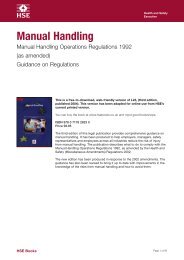Making Companies Safe - what works? (CCA ... - Unite the Union
Making Companies Safe - what works? (CCA ... - Unite the Union
Making Companies Safe - what works? (CCA ... - Unite the Union
You also want an ePaper? Increase the reach of your titles
YUMPU automatically turns print PDFs into web optimized ePapers that Google loves.
installations provides evidence of <strong>the</strong> importance of strong regulatory intervention and<br />
enforcement action, <strong>the</strong> whole purpose of <strong>the</strong> earned autonomy proposals are that HSE will<br />
withdraw from <strong>the</strong> routine regulatory intervention and inspection of those companies<br />
selected for inclusion. In <strong>the</strong> next section, <strong>the</strong>n, we will consider whe<strong>the</strong>r <strong>the</strong>re is more<br />
general evidence that some firms will successfully self-regulate in <strong>the</strong> absence of routine<br />
regulatory inspection.<br />
Is <strong>the</strong>re evidence that some employers can be trusted<br />
to self-regulate?<br />
As discussed above, a number of assumptions underlie HSE’s discussion of ‘earned<br />
autonomy’. In relation specifically to HSE’s proposals that certain duty holders be allowed to<br />
self-regulate without regulatory intervention, we must assume that implementation of a SMS<br />
by ‘good performers’ (fur<strong>the</strong>r assuming that <strong>the</strong>se can be reliably identified) will achieve <strong>the</strong><br />
following:<br />
• That it will indeed bring about <strong>the</strong> integration of OHS management into all<br />
management procedures and processes, 91 creating enterprises that are self-regulating,<br />
self-critical, and that pursue continuous improvement in relation to <strong>the</strong>ir OHS<br />
performance. 92<br />
• That in <strong>the</strong> absence of regulatory inspection, or in <strong>the</strong> context of diminished regulatory<br />
oversight and pressure, internal self-regulation and management commitment and<br />
attention to health and safety will be maintained over <strong>the</strong> long term, in <strong>the</strong> face of<br />
competing priorities and in <strong>the</strong> context of less favourable economic circumstances.<br />
What empirical evidence is <strong>the</strong>re to support <strong>the</strong>se assumptions? We are aware of only one<br />
formal experiment in <strong>the</strong> UK of <strong>the</strong> kind currently being considered by <strong>the</strong> HSE, which has<br />
been discussed by Smith and Tombs (1995):<br />
“In <strong>the</strong> mid-1980s <strong>the</strong> construction company Costain was exempted from active<br />
inspection by <strong>the</strong> HSE, on <strong>the</strong> grounds of <strong>the</strong>ir having a safety management<br />
structure and an accident record which was superior to that of most of <strong>the</strong> rest<br />
of <strong>the</strong> construction industry. Factory inspectors were subsequently instructed not<br />
to visit Costain’s sites.” 93<br />
Smith and Tombs report that <strong>the</strong> Costain experiment was short-lived. The death of an<br />
employee on site, and subsequent protests by trade unions and <strong>the</strong> media led to <strong>the</strong><br />
experiment being dropped. Whilst no definitive conclusions can be drawn from <strong>the</strong> episode,<br />
it does raise concerns ei<strong>the</strong>r that <strong>the</strong> HSE are not able to reliably identify <strong>the</strong> good<br />
performers, or that good performers that systematically manage OHS are not immune from<br />
serious safety failures.<br />
Is it possible, however, to find more general evidence that some firms in <strong>the</strong> UK may be<br />
capable of self-regulation? A review of <strong>the</strong> empirical literature suggest that individual<br />
organisations in high profile, high risk and technologically-advanced sectors will be <strong>the</strong> most<br />
likely candidates for self-regulation. First, according to Gunningham and Johnstone, <strong>the</strong>se<br />
firms will be more capable of implementing successful OHS management systems. 94 Second,<br />
it has been argued that <strong>the</strong>se enterprises will also have <strong>the</strong> highest levels of intrinsic motivation<br />
to proactively manage OHS hazards. For instance, Wright (1998) concludes on <strong>the</strong> basis of his<br />
review of <strong>the</strong> empirical research that it is possible to predict with reasonable certainty those<br />
firms that are likely to be highly motivated and proactive with regard to managing OHS, and<br />
those firms that are likely to have low levels of motivation.<br />
92<br />
‘Proactive’ firms will typically be high profile organisations operating in higher risk sectors,<br />
especially where <strong>the</strong> health and safety of customers or members of <strong>the</strong> public is regarded to<br />
be a significant risk and/ or where commercial fortunes are sensitive to adverse regulator,<br />
public or customer opinion. They are more likely to be operating in a sector where demand<br />
and supply is elastic, or where <strong>the</strong>re is a potential for substantive regulatory intervention, and<br />
where sub-standard performance is likely to be detected and acted upon by enforcing
















